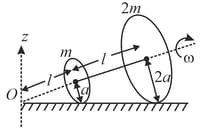In a collinear collision, a particle with an initial speed strikes a stationary particle of the same mass. If the final total kinetic energy is greater than the original kinetic energy, the magnitude of the relative velocity between the two particles after collision is

Important Questions on Centre of Mass, Momentum and Collisions
Statement-I: If there is no external torque on a body about its centre of mass, then the velocity of the centre of mass remains constant.
Statement-2: The linear momentum of an isolated system remains constant.
Two thin circular discs of mass and having radii of and respectively, are rigidly fixed by a massless, rigid rod of length through their centers. This assembly is laid on a firm and flat surface, and set rolling without slipping on the surface so that the angular speed about the axis of the rod is . The angular momentum of the entire assembly about the pointis (see the figure). Which of the following statement (s) is (are) true ?

A particle of mass experienced a perfectly elastic collision with a stationary particle of mass . What fraction of the kinetic energy does the striking particle lose, if
it recoils at right angles to its original motion direction,
the collision is a head-on one?
